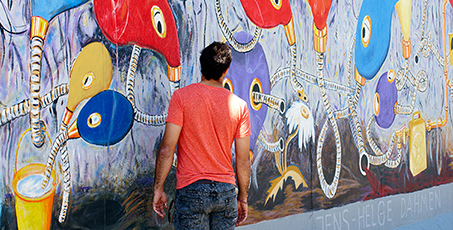40 things to do before you’re 40 - Number 21!
21. Touch the Berlin Wall
It’s April 1945 and Berlin is a long way from the “utopian” capital of the world Adolf Hitler had planned. Hundreds of thousands of Russian troops surround the bombed-out city preparing for a final attack on the Nazis, which has only women, children, pensioners, and a handful of soldiers left to defend it. Hitler and his wife Eva Braun leave their bunker rarely, but when they do they close the curtains in their Mercedes-Benz to avoid seeing the reality of their shattered city. That same month, Hitler and Braun commit suicide and Berlin falls to the Russians. The Second World War is over - 60 million people have died, and Berlin is left devastated.
Two months later, three of the most important men in the world meet to discuss the future of Europe - British Prime Minister Winston Churchill, US President Harry Truman and Soviet leader Josef Stalin. Over a couple of cigars, they agree to slice Germany into four quarters, each giving themselves (along with France) a piece of a very lucrative pie.
Crucially this story (pay attention here!), Berlin, as well as Germany, was split into four zones. The location of the city is bang in the middle of Soviet-controlled East Germany. This means that the French, American, and British sectors of Berlin were tiny islands of capitalism surrounded by a sea of communism. Check out where Berlin is in the diagram below -

The incredible events which followed are best explained in a timeline:
1948 – Conflict begins between the Soviets and the Allies regarding reconstruction and a new German currency. In response, the Soviets block off West Berlin, trapping its two million residents in their own city. The only way in and out of West Berlin is by air, and the Allies airlift in thousands of tonnes of food and fuel.
1950 – Tensions between the Soviets and Allies worsen – the name “The Cold War” is coined to describe the frosty relationship. West Berlin is prospering under capitalism, while life under communism in the East is grim. Thousands of residents begin moving to the West in search of more money and a better life.
1955 – By this time millions had defected to the West - mainly skilled workers and intellectuals (a so-called ‘brain drain’). In response, restrictions of movement between the two sides of the city increase.
1961 – On the 13th August a barbed-wire barrier was erected overnight between East and West Berlin. The following morning, families wake up separated, mothers split from their children, and workers cut off from their jobs. A few days later, a 91 mile concrete block wall is built. Residents of East were no longer allowed to enter the West - the “Iron Curtain” had fallen.
1963 – American President John F. Kennedy visits West Berlin and declares “”Ich bin ein Berliner” – a much needed morale boost to the residents. The Americans pump millions of dollars in aid into West Berlin. Attempts to flee into the West increase and the Russian guards at the wall are ordered to “shoot to kill”. It is estimated that approximately 5,000 people successfully made it to the West, however, up to 75,000 others were caught and imprisoned, and around 1,000 killed (the last person was shot in 1989).
1987 – Nearly fifteen years have passed since the wall was built when US President Ronald Reagan delivers a famous speech in front of the Brandenburg Gate. 25,000 Berliners cheered as he said: “General Secretary Gorbachev, if you seek peace, if you seek prosperity for the Soviet Union and Eastern Europe, if you seek liberalisation - come here to this gate! Mr. Gorbachev, open this gate! Mr. Gorbachev, tear down this wall.”
1989 - An announcement from the East German government that they’d start granting exit visas to anyone who wanted to go to the West was misinterpreted as meaning the border was now open. News spread rapidly and, within hours, thousands of Germans ran to the wall and starting smashing sections down with tools. East German border guards were unable to stop the rush of people to the wall. Thousands of families and friends are reunited after nearly three decades apart.

After the devastation of the Second World War and the segregation of the Cold War, Berlin has reinvented itself beyond belief since the fall of the wall. It’s now one of the most liberal, tolerant, safe, and hedonistic cities in the world, and one of the best travel destinations in the world. As you walk around this modern, thriving city, there are constant reminders of its unenviable recent history – a sprawling Holocaust memorial, the headquarters of the dreaded S.S. (now a fascinating free museum), and surviving sections of the hated Berlin Wall.
Tags: berlin, europe, germany, the berlin wall, travel bucket list, world war 2